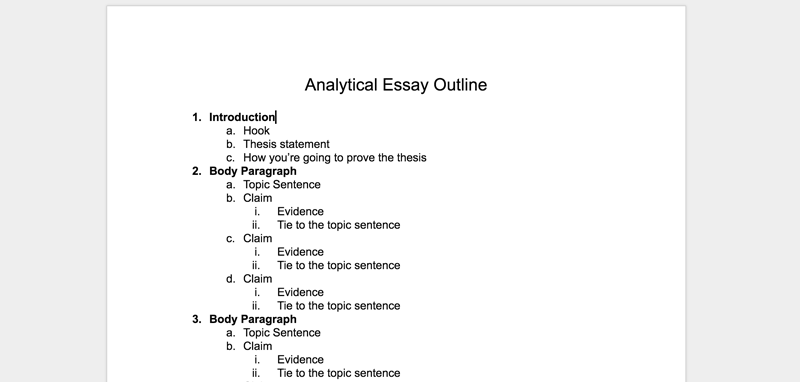
Analytical essays are structured similarly to many other essays you’ve written, with an introduction (including a thesis), several body paragraphs, and a conclusion. Below is an outline you can follow when structuring your essay, and in the next section we go into more detail on how to write an analytical essay An analytical essay is a form of writing that analyzes and examines a specific topic in-depth. It breaks the main issue into several sections and explains them one by one. This essay aims to enhance the readers’ knowledge and understanding of the subject. This essay can be written on a particular topic, non-fictional work, or any form of art The analytical essay outline format is similar to the five-paragraph structure and it contains: Introduction. Hook statement; State the thesis statement; Prove your thesis statement; Body Paragraphs. Supporting facts and evidence; Use transition words; Conclusion. Summary of the essay;
5 Steps to Write a Great Analytical Essay
What Is An Analysis Essay? An analysis is an interpretive process that draws conclusions from a set of facts. Writing an analysis starts by choosing the elements or areas of your topic that you will analyze. You will need to break down the topic, theory, issue or story that you are analyzing into its various pieces or parts.
The following are some characteristics of an analysis:. The following is an analysis outline:. Start your introduction with a hook, analytical paper outline, followed by the author, title, main characters, a short summary and finally the thesis statement. A good introduction has the following features:. The body can be organized in several ways.
They include:. Traditional — divide the body into several sections at the same level as the introduction, with names like; data, methods, analysis, analytical paper outline, results. You should describe the analyses that you have performed. Question-oriented — there is a single body section in this format called analysis and then there is a sub-section for each question raised in the introduction, usually taken in the same form as the introduction.
For each sub-section statistical method, analyses and conclusions would be described. Other organizational formats are also possible. Whatever format you choose, it is important to provide one or two well-chosen tables or graphs per question in the body because:.
The conclusion should reprise the questions in the introduction. It can also be supplemented by some additional observations and details gathered from the analysis section. Your conclusion should analytical paper outline the following:.
Include one or more appendices to place out the details and additional materials. These may include:. It is advisable to add some text sentences such as comments to make it easier for readers to follow what you are doing, analytical paper outline. The following are some characteristics of an analysis: Makes an argument or reaches a conclusion. Chooses specific elements to study. Examines and interprets each element. Discusses why each element is important. Discusses how each element connects to the others.
Might discuss analytical paper outline and effects. Might discuss advantages and disadvantages. Might discuss effectiveness and ineffectiveness. The following is an analysis outline: 1. Introduction Start your introduction with a hook, analytical paper outline, followed by the author, title, main characters, a short summary and finally the thesis statement. A good introduction has the following features: Summary of analytical paper outline study and data, as well as any relevant substantive context, background or framing issues.
The questions answered by your analysis and summaries of your conclusions about these questions. Brief outline of the remainder of the analysis. Body The body can analytical paper outline organized in several ways. They include: Traditional — divide the body into several sections at the same level as the introduction, with names like; data, methods, analysis, results. Whatever format you choose, it is important to provide one or two well-chosen tables or graphs per question in the body because: Graphical and tabular displays can analytical paper outline your points more effectively as compared to words, analytical paper outline.
Your readers will more likely be attracted to a table or graph as compared to plain text. Conclusion The conclusion should reprise the questions in the introduction. Your conclusion should include the following: Summarize your argument. Extend the argument. Show why the text is important, analytical paper outline.
Appendix Include one or more appendices to place out the details and additional materials. These may include: Technical descriptions of statistical procedures. Detailed tables or computer output. Figures analytical paper outline were not central to the arguments presented in the body of the analysis. Computer code used to obtain results. SELL YOUR OLD PAPERS. Recent Posts Harry Potter and the Categories Academic Writing 23 Admission Essay Book Summaries 53 College Tips Content Writing Services 1 Essay Help Essay Writing Help 76 Essays Blog 0 Example 26 Infographics 2 Outlines Photo Essay Assignment 4 Resume Writing Tips 62 Samples Essays Writing Jobs 2.
GMAT AWA: HOW I GOT READY IN 2 HOURS (700+)
, time: 9:55A Guide on an Analytical Essay Outline with Examples

An analytical essay is a form of writing that analyzes and examines a specific topic in-depth. It breaks the main issue into several sections and explains them one by one. This essay aims to enhance the readers’ knowledge and understanding of the subject. This essay can be written on a particular topic, non-fictional work, or any form of art The analytical essay outline format is similar to the five-paragraph structure and it contains: Introduction. Hook statement; State the thesis statement; Prove your thesis statement; Body Paragraphs. Supporting facts and evidence; Use transition words; Conclusion. Summary of the essay; An analysis is an interpretive process that draws conclusions from a set of facts. It involves breaking down something into its various elements and asking critical thinking questions such as ‘why’ and ‘how’ in order to reach your own conclusions

No comments:
Post a Comment